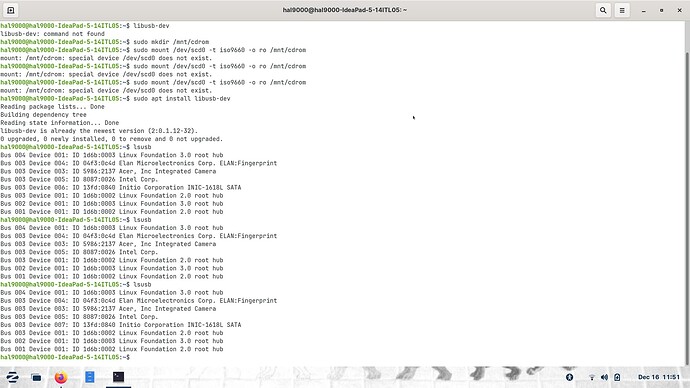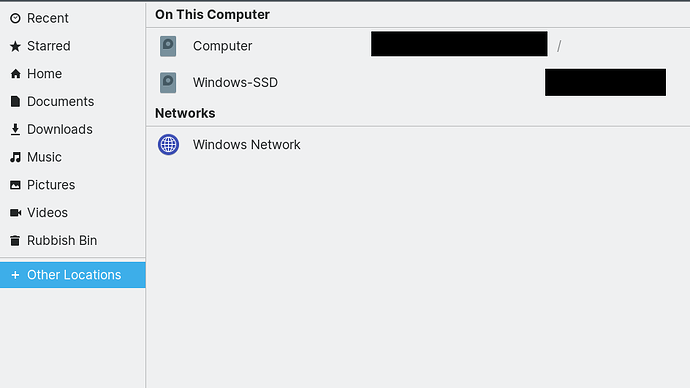I'm trying to install an external CD player but I can't get the Terminal response I was expecting. What am I missing?
So, I see one thing - where you have your commands, you have mount/dev/... which is a little mashed together. Try with putting a space between the first command, then the path:
sudo mkdir /mnt/cdrom
sudo mount /dev/cdrom_name_here /mnt/cdrom
Since you're writing / mounting a device, you'll have to use 'sudo' to elevate privileges.
Also, that should be auto-mounting being USB, I'm assuming. But, if it is - might want to install libusb-dev. That package has extras for USB support / drivers; could be useful!
Many CD players are also plug n play - you plug it in and it automounts. If you do not have that kind, you may want to add the device I.D. to the ``fstab` file so that it mounts when you plug it in.
Could you walk me through how to do that? According to the box, this is a plug and play compatible with Linux but the icon I expect to see isn't showing up in the bottom tray or the desktop. The computer makes a noise when the player is plugged in and the player makes noise like it wants to work but I can't figure out where to go to see the controls.
Where could I find out what the proper name of the unit is? It's not on the box or in what passes for a manual. Is it the: scd0 -t iso9660 -o ro
from the Google site?
When you plug in your external, issue lsusb - what's the output?
You may have to use /dev/ttyUSB0 instead of the device name - can check the /dev directory when it's plugged in to see what's new in the list.
Also - did you install the libusb-dev package? Just a suggestion, might or might not have a different outcome with it installed and trying the external again.
What was entered in Google won't really do much - unless that device is in the /dev directory but, I'm assuming not since nothing happened haha I'm fairly certain that it won't be the same when connected.
Yes. libusb-dev is installed. So apparently it's the Initio corporation line. Do I substitute the ID number for the name? (13fd:0840)
No, in /dev there should be a new entry - since it's USB, I would assume it's the /dev/ttyUSBX (X = 0, 1, 2, 3, 4, etc..) you can compare before plugging in what's displayed for /dev and then displaying again with the external plugged in. But willing to bet it's 'ttyUSBX'.
Did you reboot after installing libusb-dev? Usually requires a reboot or logout / in before changes can be seen. But, if not that may not be helping either.
Can you provide the Brand Make and Model or a link to it for sale (Amazon, ,for example)?
Have you tested switching USB ports - not using a USB Hub?
Also forgot to ask - did you try popping a disc in the drive? It might auto-mount after inserting a disc..
I've plugged it directly into both USB ports.
Also, there's a CD in it but no joy.
Yeah, that should just.. work ![]()
This is the one I went with - though, only works once with the touch eject button, after that nothing lol have to manually eject from the menu.
Did it come with any discs at all for drivers? Wasn't sure if so, and if there were any on there that would reflect Ubuntu or not.
In the Terminal picture above, the only change in the middle when the player was unplugged is the absence of the Initio Corporation line. When I put /dev in Terminal, I get: bash: /dev: Is a directory. Nothing is showing up there.
Didn't come with any disks for drivers. I reboot occasionally but no help.
The first line in the Product Details says (bold mine):
The external DVD/CD drive doesn't support Blu-ray Discs / TV / Car / Truck / Android Phone & Tablet / Chromebook / iPhone / iPad / Ubuntu OS.
Zorin OS is based on Ubuntu OS.
I bolded Chromebook since Chromebook is also a GnuLinux using OS.
Further notes: Android is a rather Modified Linux kernel. iPhone and iPad also use a Unix-like kernel. So, it is highly likely that device is flashed for Microsoft only.
It says below that:
Supported System: Compatible with Windows 2003/Wind8.1/Wind10/Vista/7, Linux,Mac10 OS system
Which contradicts itself. I suspect marketing or copy/paste laziness.
Ah - to list what's in a directory, issue ls - so, ls /dev and that will show you all that's in that directory. You could do it with a text file if you want as well:
ls -1 /dev > ~/before.txt
Then plug in the device:
ls -1 /dev > ~/after.txt
diff ~/before.txt ~/after.txt
That should give you an output in your home directory of what's in before / after the plugin. That can help, especially with the length of that directory ![]()
I see that now. It didn't mention the exclusionary parts on the box. I guess I stopped reading after it said it was compatible with Windows, Linux and Mac.
I must not be putting in the right spaces or something because a lot of the commands you give me aren't producing a response in Terminal. But ls /dev worked and I can see two lines from the /dev file that come and go with plugging in the player:
cdrom i2c-5 rfkill tty31 ttyprintk vcs
cdrw i2c-6 rtc tty32 ttyS0 vcs1
In light of what Aravisian pointed out about compatibility, do you think we can do a work around? There's nothing on the box that says it's not compatible with Linux.
It's possible that could be the case; that it might be a Win only kinda thing. No shame in trying though haha might work after all!
So - in that case I would try (assuming the /mnt/cdrw directory is not present):
sudo mkdir /mnt/cdrw
sudo mount /dev/ttyS0 /mnt/cdrw
And see if that mounts.
By the way - you can copy / paste the commands in terminal if that's easier. But, you also have a tty32 - is that verbatim from the terminal output? Could also try the 'tty32' or 'tty31' as well, but try the 'ttyS0' one first - that's serial.
Which might also be blocked by something else as well. (unrelated) I had an OBDII ECU code reader being recognized as a braille display ![]() lol just had to remove the driver and it was able to mount on ttyUSB0. Not exactly what you have going on though, but just a weird nuance of a not well-known device, heh..
lol just had to remove the driver and it was able to mount on ttyUSB0. Not exactly what you have going on though, but just a weird nuance of a not well-known device, heh..
Right - the problem is that the drive isn't mounting. So, wouldn't show in 'Other Locations' or file manager until mounted.
Which is odd - I have an external drive myself, cheapie; but does auto-mount. Much like another internal drive issue - this one is being read as two types of drives, which is cool - one CDROM one CDRW.. But, since it's technically on the same bus, it may be trying to mount "two" drives to one location - if that makes sense..


